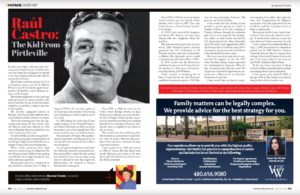Raúl Castro: The Kid From Pirtleville
Raúl Castro: The Kid From Pirtleville 
By Marshall Trimble
It’s been more than a 100 years since Arizona gained statehood, yet in all that time only one Latino has managed to be elected to the state’s highest political office. But he was one hell of a man.
Raúl Castro was born on June 12, 1916, in Cananea, Sonora, one of 14 children. When he was 10, the family legally immigrated to Pirtleville, a small Mexican village outside Douglas.
His mother taught him to read and at an early age he took an interest in politics. His father died when he was 12 and his mother worked as a midwife in order to keep her family together.
He attended segregated schools in Douglas. The Mexican kids walked to their school while the white students rode buses.
The local swimming pool was also segregated and during the hot summer days the Mexican kids were allowed to swim only on Saturday afternoon just before they drained and cleaned the pool.
In spite of all this, Castro was a good student, made good grades, was quarterback on the Douglas High School football team, a sprinter in track, and on the boxing team.
When Castro graduated from high school he wanted to go to college but was told Mexicans had a difficult time getting in and if they did manage to graduate, they still couldn’t get a good job.
He persisted and won a scholarship to play football at Arizona State College at Flagstaff (NAU). He was also captain of the track team and a member of the boxing team. Fighting as a middleweight, he never lost a bout.
In 1939, during his senior year, Castro taught students at the Flagstaff Elementary School. Teaching was where he found his greatest sense of accomplishment. That same year he became a naturalized citizen.
He returned to Douglas after graduating and applied for a teaching position but was turned down because he was a Mexican immigrant.
So, he hopped a freight train and headed for California where he boxed professionally, earning $50 a match. He also worked as a farmhand. Castro was an angry young man but decided to turn that anger into determination. He returned to Arizona determined to make good.
From 1941 to 1946, he served in the United States Foreign Service at Agua Prieta, Sonora, Mexico, just across the border from Douglas. Following that experience, he spent the next three years teaching Spanish at the University of Arizona. During that time, he applied to law school at the university.
He was told by the dean of the law school that his duties as an instructor would interfere with his studies. However, the president of the university convinced the dean to give him a chance.
Castro graduated in 1949 and opened an office in Tucson. His first clients were mostly Mexicans and much of the time they could only afford to pay him in tortillas. Still he persisted.
From 1951 to 1954 he served as deputy county attorney and was elected county attorney from 1954 to 1958. That year, Castro became a Pima County Superior Court Judge.
In 1959, Castro married his longtime sweetheart, Pat Steiner, and they were blessed with two daughters, Mary Pat and Bess.
His national stature grew over the years and in 1964 President Lyndon Johnson appointed him U.S. Ambassador to El Salvador and four years later, Ambassador to Bolivia. His diplomatic service ended when Johnson retired from office in 1969.
In 1970, Castro was the Democratic candidate for governor of Arizona but lost the election in a close race to the incumbent, Republican, Jack Williams.
Castro returned to practicing law in Pima County but he was the Democrat candidate for governor again in 1974. This time he won, becoming Arizona’s 14th governor and the first Latino.
A few weeks after his election, Castro attended a grand opening of a bank in Nogales, Sonora. As he was returning to Nogales, Arizona, through the pedestrian gate, Castro was stopped by the immigration officer on duty. Castro declared his U.S. citizenship but the officer demanded proof. He smiled and suggested the officer call Senator Barry Goldwater and ask if it was okay for the governor-elect of Arizona to be admitted back into his state.
His tenure was short and relatively uneventful. He resigned on Oct. 20, 1977, when President Jimmy Carter appointed him Ambassador to Argentina. Were his days of dealing with prejudice over? The Argentines resented his appointment, saying he was a Mexican not an American. Sometimes ya can’t win.
Castro would later say that he regretted resigning from office after only two years and disappointing the Hispanic community who had supported him but he felt he could be of greater service to them as ambassador.
Throughout his life Castro faced obstacles but to him they only made him stronger. “I viewed these situations as just one more dilemma I had to overcome,” he said.
Castro resigned his ambassadorship on Aug. 1, 1980, and returned to Arizona to practice law. In 2007 Northern Arizona University honored him by naming their College of Social and Behavior Science for him. A few years earlier he was inducted into NAU’s Athletics Hall of Fame.
To the end, Castro never tired of talking to school children, especially Latinos, always encouraging them to get an education.
Castro passed away April 10, 2015, at the age of 98 in San Diego in an assisted living facility while in hospice care.
Governor Raúl Castro and Marshall Trimble, the writer of this piece, were members of the Central Arizona League of Women’s Class of 2014 Arizona Historymakers. They first met in 1975 when Trimble wrote a couple of speeches for Castro during America’s Bicentennial.
Related posts
Leave a Comment
You must be logged in to post a comment.






